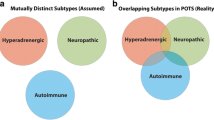Summary
To compare the readings of blood pressure by the Riva-Rocci (RR) method with those of peripheral arterial pressure (PAP) as recorded by the Finapres (FP) device, exercise was performed by six male subjects on a cycle ergometer at a constant exercise intensity of 140 W. In addition, forearm volume was determined by impedance plethysmography. At rest, systolic FP values exceeded RR values by ≥ 10 mmHg. During 60-min exercise both values at first increased almost in parallel with each other. While RR reached a plateau after 3 min, FP then started to decrease continuously up to the 10th min and finally stabilized at 20–30 mmHg below RR. The impedance values showed a similar declining slope, indicating vasodilatation. To separate the effects of sympathetic drive from heat elicited vasodilatation, a second experimental series was performed with ischaemic static calf exercise (5 min, 90 N), since this increases the sympathetic tone but prevents systemic heat distribution. In contrast to findings reported from intra-arterial measurements, no exercise effect on the pulse pressure amplification was obtained. However, the heating of one fingertip distal to the FP-cuff led to a significant decrease in PAP compared to the control recording made simultaneously from the other hand. It was concluded that heat induced vasodilatation may make FP unrepresentative of systemic blood pressure, in particular during exercise. Moreover, the FP-cuff seemed to induce substantial vasoconstriction due to venous occlusion. The FP method would therefore be useful for monitoring continuously systemic blood pressure if no (dilative) vasomotor changes occurred or their ranges and time courses were known sufficiently well.
Similar content being viewed by others
References
Bevegard BS, Shepherd JT (1966) Reaction in man of resistance and capacity vessels in forearm and hand to leg exercise. J Appl Physiol 21:123–132
Blair DA, Glover WE, Roddie IC (1961) Vasomotor responses in the human arm during leg exercise. Circ Res 9:264–274
Boehmer RD (1987) Continuous, real-time, noninvasive monitor of blood pressure: Penaz' methodology applied to the finger. J Clin Monit 3:282–287
Dorlas JC, Nijboer JA, Butjin WT, van der Hoeven MA, Settels JJ, Wesseling KH (1985) Effects of peripheral vasoconstriction on the blood pressure in the finger, measured continuously by a new noninvasive method (the Finapres). Anaesthesiology 62:342–345
Golenhofen K (1971) Haut, Skelettmuskulatur. In: Bauereisen E (ed) Physiologie des Kreislaufs, vol. 1, Springer, Berlin Heidelberg New York
Gravenstein JS, Paulus DA, Feldmann J, McLaughlin G (1985) Tissue hypoxia distal to a Penaz' finger blood pressure cuff. J Clin Monit 1:120–125
Hales JRS, Jessen C, Fawcett AA, King RB (1985) Skin AVA and capillary dilatation and constriction induced by local skin heating. Pflügers Arch 404:203–207
Hirata K, Nagasaka T, Nunomora T, Cabanac M (1988) Local thermal sensation and finger vasoconstriction in the locally heated hand. Eur J Appl Physiol 58:92–96
Henriksen O, Sejrsen P (1977) Local reflex in microcirculation in human skeletal muscle. Acta Physiol Scand 99:19–26
Johnson JM, Rowell LB (1975) Forearm skin and muscle vascular responses to prolonged leg exercise in man. J Appl Physiol 39:920–924
Kroeker EJ, Wood EH (1955) Comparison of simultaneously recorded central and peripheral arterial pressure pulses during rest, exercise and tilted position in man. Circ Res 3:623–631
Kurki T, Smith NT, Head N, Dec-Silver H, Quinn A (1987) Noninvasive continuous blood pressure measurement from the finger: optimal measurement conditions and factors affecting reliability. J Clin Monit 3:6–13
Nijboer JA, Dorlas JC, Lubbers J (1988) The difference in blood pressure between upper arm and finger during physical exercise. Clin Physiol 8:501–510
Parati G, Casadei R, Gropelli A, di Rienzo M, Mancia G (1989) Comparison of finger and intra-arterial blood pressure monitoring at rest and during laboratory testing. Hypertension 13:647–655
Penaz J, Voigt A, Teichmann W (1976) Beitrag zur fortlaufenden indirekten Blutdruckmessung. Z Inn Med 31:1030–1033
Rowell LB (1980) What signals govern the cardiovascular responses to exercise? Med Sci Sports 12:307–315
Rowell LB, Brengelman GL, Blackmon JR, Bruce RA, Murray JA (1968) Disparities between aortic and peripheral pulse pressure induced by upright exercise and vasomotor changes in man. Circulation 37:954–964
Stebbins CL, Longhurst C (1989) Potentiation of the exercise pressure reflex by muscle ischemia. J Appl Physiol 66:1046–1053
Stegemann J (1963) Zum Mechanismus der Pulsfrequenzeinstellung durch den Stoffwechsel. 1. Der Einfluß des Stoffwechsels in einer vom Kreislauf isolierten Muskelgruppe auf das Verhalten der Pulsfrequenz. Pflügers Arch 276:481–492
Stick C (1981) Zur Problematik der Messung filtrationsbedingter Volumenänderungen der Extremitäten mit der Impedanzplethysmographie. Eur J Appl Physiol 47:405–418
Stick C, Grau H, Witzleb E (1985) On physiological oedema in man's lower extremity. Eur J Appl Physiol 54:442–449
Wesseling KH, de Wit B, Settels JJ, Klawer WH (1982) On the indirect registration of finger blood pressure after Penaz. Funkt Biol Med 1:245–250
Wesseling KH, Settels JJ, van der Hoeven GMA, Nijboer JA, Butijn MWT, Dorlas JC (1985) Effects of peripheral vasoconstriction on the measurement of blood pressure in a finger. Cardiovasc Res 19:139–145
Author information
Authors and Affiliations
Rights and permissions
About this article
Cite this article
Hildebrandt, W., Schütze, H. & Stegemann, J. On the reliability of the Penaz cuff during systemic and local fingertip vasodilatation at rest and in exercise. Europ. J. Appl. Physiol. 62, 175–179 (1991). https://doi.org/10.1007/BF00643738
Accepted:
Issue Date:
DOI: https://doi.org/10.1007/BF00643738




